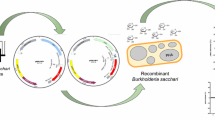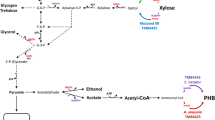Abstract
Hyaluronic acid (HA) has been industrially produced using the gram-positive bacterium Streptococcus zooepidemicus. Large amount of lactic acid formation was one of the important factors that restricted cell growth and HA productivity and lowered the substrate to HA conversion efficiency in a fermentor. In this study, polyhydroxybutyrate (PHB) synthesis genes (phbCAB) of Ralstonia eutropha were cloned from the plasmid pBHR68 and were inserted into the plasmid pEU308, an expression vector for gram-positive bacteria. The plasmid was transformed into S. zooepidemicus by electroporation. β-Ketothiolase (PhbA), acetoacetyl-CoA reductase (PhbB), and polyhydroxyalkanoate (PHA) synthase (PhbC) activity assays were carried out to demonstrate the expression of these genes. The PhbA and PhbB activities were 3.13 and 1.23 U mg−1, respectively. No PhbC activities were detected. In shake flask studies, there was no obvious difference between the wild-type and recombinant S. zooepidemicus harboring phbCAB genes in terms of lactic acid and HA formation. However, in fermentor studies, the recombinant produced only 40 g L−1 lactic acid and 7.5 g L−1 HA, whereas the wild type produced 65 g L−1 lactic acid and 5.5 g L−1 HA. These results suggested that expression of phbCAB genes in S. zooepidemicus could help regulate HA production metabolism. Because the lactic acid formation in S. zooepidemicus was sensitive to cellular oxidation/reduction potential, it is proposed that the PHB synthesis pathway could act as a regulator to adjust the cellular oxidation/reduction potential. This is the first study demonstrating that PHA synthesis related to energy and carbon metabolism could be employed as a pathway to regulate other cellular metabolism and possibly to regulate the production of other metabolic products.


Similar content being viewed by others
References
Bitter T, Muri HM (1962) A modified uronic acid carbazol reaction. Anal Biochem 4:330–334
Bradford MM (1976) A rapid and sensitive method for the quantitation of microgram quantities of protein utilizing the principle of protein–dye binding. Anal Biochem 72:248–254
Chen AP, Hillman JD, Duncan M (1994) l-(+)-Lactic acid dehydrogenase deficiency is lethal in Streptococcus mutans. J Bacteriol 176:1542–1545
Chen JY, Liu T, Zheng Z, Chen JC, Chen GQ (2004) Polyhydroxyalkanoate synthases PhaC1 and PhaC2 from Pseudomonas stutzeri 1317 had different substrate specificities. FEMS Microbiol Lett 234:231–237
Chong BF, Nielsen LK (2003a) Amplifying the cellular reduction potential of Streptococcus zooepidemicus. J Biotechnol 100:33–41
Chong BF, Nielsen LK (2003b) Aerobic cultivation of Streptococcus zooepidemicus and the role of NADH oxidase. Biochem Eng J 16:153–162
David CA, Michael RJ (1997) Culture conditions affect the molecular weight properties of hyaluronic acid produced by Streptococcus zooepidemicus. Appl Environ Microbiol 63:2759–2764
Eichenbaum Z, Federle MJ, Marra D, de Vos W, Kuipers OP, Kleerebezem M, Scott JR (1998) Use of the lactococcal nisA promoter to regulate gene expression in gram-positive bacteria: comparison of induction level and promoter strength. Appl Environ Microbiol 64:2763–2769
Gao HJ (1999) Process optimization and metabolic network analysis of hyaluronic acid synthesis by Streptococcus zooepidemicus. Dissertation, Southern Yangtze University
Garrigues C, Loubiere P, Lindley ND, Cocaign-Bousquet M (1997) Control of the shift from homolactic acid to mixed-acid fermentation in Lactococcus lactis: predominant role of the NADH/NAD+ ratio. J Bacteriol 179:5282–5287
Geueke B, Riebel B, Hummel W (2003) NADH oxidase from Lactobacillus brevis: a new catalyst for the regeneration of NAD. Enzyme Microb Technol 32:205–211
Holmstrom B, Ricica J (1967) Production of hyaluronic acid by a streptococcal strain in batch culture. Appl Microbiol 15:1409–1413
Jeffrey D, Jacky L (1996) Genetic and physiological analysis of the lethal effect of lactic acid dehydrogenase deficiency in Streptococcus mutans: complementation by alcohol dehydrogenase from Zymomonas mobilis. Infect Immun 64:4319–4323
Johns MR, Goh LT, Oeggerli A (1994) Effect of pH, agitation and aeration on hyaluronic acid produced by Streptococcus zooepidemicus. Biotechnol Lett 15:507–512
Kester RM, Lesser S, Dowd LL (1993) Bacteria isolated from equine respiratory cultures. Equine Pract 15:33–36
Lee SY, Choi J, Wong HH (1999) Recent Advances in polyhydroxyalkanoate production by bacterial fermentation: mini-review. Int J Biol Macromol 25:31–36
McCool GJ, Cannon MC (1999) Polyhydroxyalkanoate inclusion body-associated proteins and coding region in Bacillus megaterium. J Bacteriol 181:585–592
Nimrod A (1988) Method of producing high molecular weight sodium hyallronate by fermentation of streptococcus. US Patent 4,780,414
Nishimura T, Saito T, Tomita K (1978) Purification and properties of β-ketothiolase from Zoogloea ramigera. Arch Microbiol 116:21–27
O’Regan M, Martini I, Crescenzi F, de Luca C, Lansing M (1994) Molecular mechanisms and genetics of hyaluronan biosynthesis. Int J Biol Macromol 16:283–286
Rehm BHA, Mitsky TA, Steinbüchel A (2001) Role of fatty acid de novo biosynthesis in polyhydroxyalkanoic acid (PHA) and rhamnolipid synthesis by pseudomonads: establishment of the transacylase (PhaG)-mediated pathway for PHA biosynthesis in Escherichia coli. Appl Environ Microbiol 67:3102–3109
Rehm BHA, Antonio RV, Spiekermann P, Amara AA, Steinbüchel A (2002) Molecular characterization of the poly(3-hydroxybutyrate) (PHB) synthase from Ralstonia eutropha: in vitro evolution, site-specific mutagenesis and development of a PHB synthase protein model. Biochim Biophys Acta 1594:178–190
Ross RP, Claiborne A (1992) Molecular cloning and analysis of the gene encoding the NADH oxidase from Streptococcus faecalis 10C1. Comparison with NADH peroxidase and the flavoprotein disulfide reductases. J Mol Biol 227:658–671
Sambrook J, Russell DW (2001) Molecular cloning: a laboratory manual, 3rd edn. Cold Spring Harbor Laboratory, Cold Spring Harbor
Senior PJ, Dawes EA (1973) The regulation of poly-β-hydroxybutyrate metabolism in Azotobacter beijerinckii. Biochem J 134:238–255
Spiekermann P, Rehm BHA, Kalscheuer R, Baumeister D, Steinbüchel A (1999) A sensitive, viable-colony staining method using Nile red for direct screening of bacteria that accumulate polyhydroxyalkanoic acids and other storage compounds. Arch Microbiol 171:73–80
Stanton TB, Sellwood R (1999) Cloning and characteristics of a gene encoding NADH oxidase, a major mechanism for oxygen metabolism by the anaerobic spirochete, Brachyspira (Serpulina) hyodysenteriae. Anaerobe 5:539–546
Yansura DG, Henner DJ (1984) Use of the Escherichia coli lac repressor and operator to control gene expression in Bacillus subtilis. Proc Natl Acad Sci U S A 81:439–443
Acknowledgements
We are grateful to Professor A. Steinbüchel of the University of Muenster/Germany for the kind donation of plasmid pBHR68 and to Dr. R. Scott for providing the plasmid pEU308. Thanks are also extended to Drs. L.K. Nielsen and J.R. Scott for their advice on transformation of S. zooepidemicus.
Author information
Authors and Affiliations
Corresponding author
Rights and permissions
About this article
Cite this article
Zhang, J., Hao, N. & Chen, GQ. Effect of expressing polyhydroxybutyrate synthesis genes (phbCAB) in Streptococcus zooepidemicus on production of lactic acid and hyaluronic acid. Appl Microbiol Biotechnol 71, 222–227 (2006). https://doi.org/10.1007/s00253-005-0164-x
Received:
Revised:
Accepted:
Published:
Issue Date:
DOI: https://doi.org/10.1007/s00253-005-0164-x




